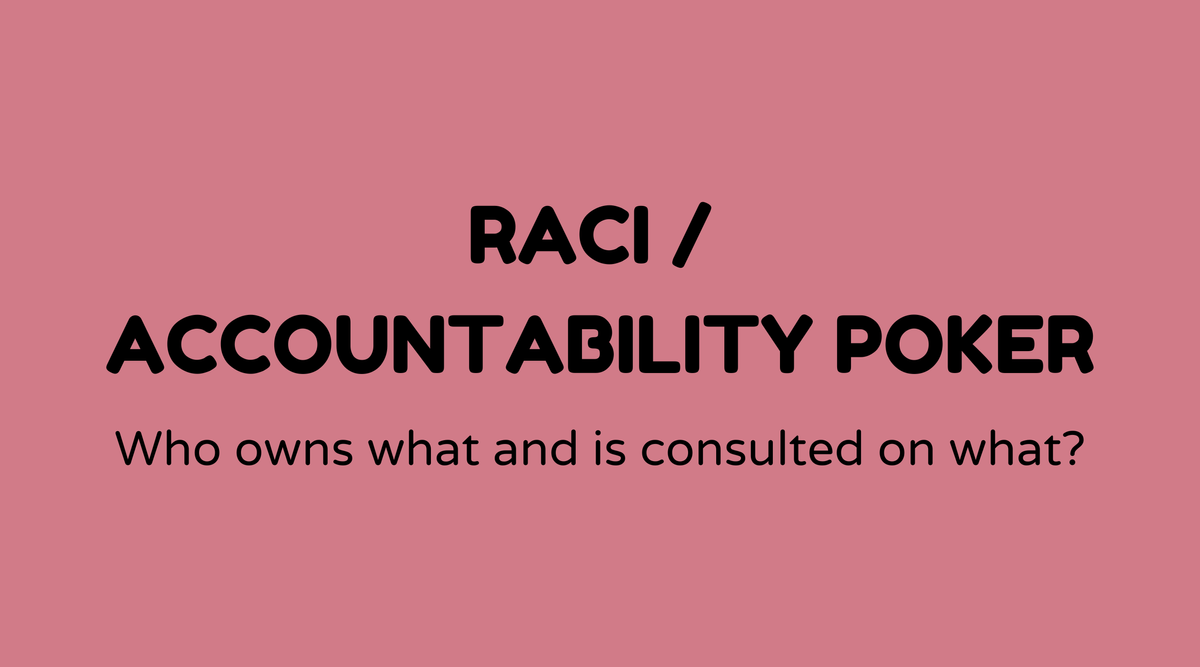RACI / Accountability Poker

Overview of RACI / Accountability Poker Workshop:
RACI / Accountability Poker is an engaging activity aimed at clarifying team responsibilities and enhancing collaboration within a project. This workshop creatively combines structured role definition with the interactive elements of poker, resulting in an enjoyable and insightful experience for participants.
Why RACI / Accountability Poker Matters:
In any project, unclear roles can act as a significant barrier. Miscommunication about individual responsibilities often leads to delays and inefficiencies. The RACI / Accountability Poker workshop addresses these challenges directly by transforming the process of assigning responsibilities into a collaborative and enjoyable activity. This emphasis on role clarity not only boosts productivity but also cultivates trust and communication within the team, facilitating smoother future projects.
What is RACI / Accountability Poker:
The RACI model encompasses four designations: Responsible, Accountable, Consulted, and Informed—a system that clarifies roles and responsibilities in a project or business scenario. Implementing this framework through an Accountability Poker workshop allows teams to use poker-style cards to actively discuss and assign these roles. It is a simplified and interactive method for resolving uncertainties in project management.
How to Conduct RACI / Accountability Poker:
To carry out a productive RACI / Accountability Poker workshop, follow these steps:
-
Preparation: Identify the key activities and tasks critical for the project’s success. Provide poker-style cards representing the various roles: Responsible, Accountable, Consulted, and Informed.
-
Execution: Facilitate a roundtable discussion where each participant shares their card for each task, explaining their rationale. This promotes dialogue and ensures everyone has a clear understanding of the roles.
-
Convergence: The group reviews the proposed roles together and comes to an agreement on RACI assignments, thereby resolving any confusion.
-
Documentation: Record the agreed roles and communicate them to the broader team to ensure transparency and commitment.
Sample Agenda of RACI / Accountability Poker:
- Introduction (15 mins): Outline the concept and objectives of the workshop.
- Role Identification (30 mins): Enumerate all tasks and roles within the project.
- Poker Session (45 mins): Participate in the card activity to assign roles.
- Discussion and Consensus (30 mins): Address any disagreements and finalize roles.
- Wrap-Up (15 mins): Recap decisions, next steps, and solicit feedback.
Examples of RACI / Accountability Poker:
-
Tech Startup Project: A software development team encounters issues with late deliverables, with unclear responsibilities identified as a core problem. The workshop can help clarify each member's contributions.
-
Construction Project: In a large-scale building initiative, clearly assigning roles for project managers, site developers, and consultants can prevent typical issues, such as budget overruns and mismanaged tasks.
FAQs
What does RACI stand for?
RACI signifies four types of responsibilities: Responsible, Accountable, Consulted, and Informed.
How long does a RACI / Accountability Poker workshop take?
Generally, these workshops span two to three hours, depending on project complexity and team size.
Is RACI / Accountability Poker suitable for remote teams?
Yes, it can be effectively executed using video conferencing tools and digital cards.
What are the advantages of using RACI / Accountability Poker?
Enhanced clarity, improved team communication, and greater efficiency in project management are among the primary advantages.
Can RACI / Accountability Poker be applied in non-business contexts?
Absolutely. This method can be tailored for any situation requiring clear task distribution, such as community projects or educational endeavors.
How often should RACI / Accountability Poker be conducted?
Ideally, it should be implemented at the start of each new project or when reassessing existing roles to ensure alignment and enhance team performance.



